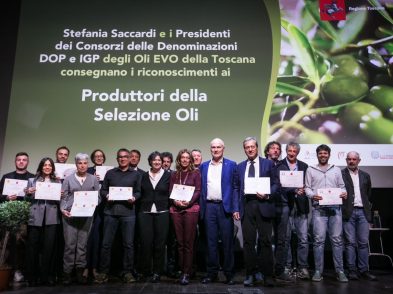Colonnata, a very small town high up in the white marble mountains of Carrara, near the Tuscan coast, is known for its lardo, the cured back fat of the pig, a high-energy food developed out of necessity: to keep workers sustained during their several-day shifts working in the marble caves and quarries. Consequently, the area, long renowned for the best and purest white marble in the world, is also famed for its creamy white lardo, each year’s batch available from May 30. I visited Colonnata recently for some respite from the heat and, most importantly, to taste this year’s lardo, feeding my obsession with all things piggy. This time of year, lardo is perfect as part of a ‘surf and turf’ pairing.
Giovanni is one of Colonnata’s local producers of lardo. His mother has a shop there where she sells her lardo, among other things. She says her family has been making lardo for around 2,000 years, and now her son makes it. He also works for a large company curing lardo to export worldwide. Altogether, he told me, he cures 500,000 kilograms of the white stuff every year.
If you visit Colonnata and are lucky enough to come across Giovanni, he will show you his curing room and open up one of the conche di marmo, large Carrara marble curing chambers that hold up to 500 kilograms of pork fat and almost 150 kilograms of salt, which is used to make the salamoia (brine), along with pepper, herbs and spices.
Although I make my own lardo (see TF 156), I love the lardo made in the cool, windy mountains of Carrara. This is the flavour I aim for, but, try as I might, the lardo from Colonnata will always be different because of the air, climate and geographical conditions. That said, there are individual differences: some curers include cannella (cinnamon) and chiodo di garofano (clove) for a sweeter tasting, more fragrant lardo; others add rosemary and garlic to give it a more savoury taste.
After a serious taste of lardo from various producers I decided to take some home and use it to make a light summer dish, the recipe I share with you here. I am not going into the marble caves for three days, so I don’t need to eat lots of lardo for energy. Instead, I slice it thinly and wrap it around prawns and fresh mint.
Buon appetito!

Gamberoni con mentuccia e lardo di Colonnata (serves 4–6)
Ingredients
24 gamberi (large fresh prawns)
24 slices of lardo di Colonnata
1 bunch fresh mint
extra-virgin olive oil
pepper to taste
24 toothpicks
Preparation
Begin by removing the intestinal tracts of the prawns: With a skewer, make an incision under the second shell from the head of the prawn and into the flesh, sliding the skewer underneath the intestine, which runs all the way down to the tail. Pull the skewer back out slowly, at the same time easing the intestine out with the skewer. Discard and repeat for the each remaining prawn. Then peel the prawns, removing the shell and the legs but leaving the heads and the tails on. Wash in cool running water briefly to remove any extra bits of shell or sand and pat dry. Do not soak them in water: you will remove the flavour from the prawns.
If you have an affettatrice (a slicer), get a nice wide piece of lardo and slice into fine ribbons. If you don’t have one, when you purchase the lardo, ask your local salumeria (deli) to slice it thin for you. Leave the sa+lt on the top of the lardo.
Pick the mint leaves and discard the stalks. Wash and pat dry, then finely chop. Place in a bowl big enough to fit all the prawns, add 50ml of extra-virgin olive oil and some freshly cracked pepper. Toss the prawns in the oil and mint and leave to sit in the fridge for 30 minutes to soak up the flavours.
Remove from the fridge and drain any excess oil from the prawns. Wrap one fine slice of lardo and around each prawn to cover the flesh but not the shell of the head or tail, securing the lardo with a toothpick.
Heat up a large frypan and, when hot, drizzle in a small amount of extra-virgin olive oil. Place the prawns in the pan, sauté for around 45 seconds on one side before turning to colour the other, turn the flame down and cook for a total of 2 minutes. The prawns are ready as soon as they become opaque all the way through—they don’t need any more cooking. The lardo will be melted and crispy in parts. Transfer to serving plates, finish with a little more freshly cracked pepper and finely chopped fresh mint, and serve with a nice, big crispy green salad with a mixture of all types of pomodori. Season with salt and extra-virgin olive oil.
Wine Match
A wine I like with this dish is one of my favourite rosé wines in Tuscany: Bolgheri Rosato ‘Scalabrone’ Guado al Tasso, Antinori 2012. The freshness and sapidity balance the sweetness of the prawns and the lardo.







